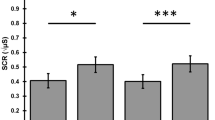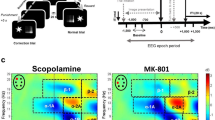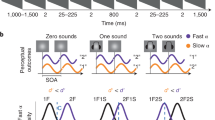Abstract
SEVERAL studies have shown that scopolamine hydrobromide, a peripheral cholinergic blocking agent1, increases responding in situations which require response suppression2,3. Other studies4 have demonstrated similar behavioural effects when cholinergic function was modified by anticholinesterases. This disruption has been attributed to either impairment of sensory input2 or response disinhibition5. These hypotheses were tested by using a form of analysis based on the theory of signal detectability (TSD), which originated in work on electronic communication systems and has been extended to sensory psychology6. It has been particularly useful in psychophysics because it yields independent estimates of a subject's sensitivity to stimuli and his response bias.
This is a preview of subscription content, access via your institution
Access options
Subscribe to this journal
Receive 51 print issues and online access
$199.00 per year
only $3.90 per issue
Buy this article
- Purchase on Springer Link
- Instant access to full article PDF
Prices may be subject to local taxes which are calculated during checkout
Similar content being viewed by others
References
Goodman, L. S., and Gilman, A., The Pharmacological Basis of Therapeutics (Macmillan, New York, 1965).
Carlton, P. L., in Anticholinergic Agents (edit. by Bradley, P. B., and Fink, M.), 48 (Elsevier, Amsterdam, 1968).
Warburton, D. M., and Groves, P., Commun. Behav. Biol., 3, 361 (1969).
Warburton, D. M., J. Comp. Physiol. Psychol., 68, 56 (1969).
Bignami, G., in Neuro-Psycho-Pharmacology (edit. by Brill, H.), 819 (Excerpta Medica, Amsterdam, 1967).
Green, D. M., and Swets, J. A., Signal Detection Theory and Psychophysics (Wiley, New York, 1966).
Harzem, P., in Animal Discrimination Learning (edit. by Gilbert, R. M., and Sutherland, N. S.), 299 (Academic Press, London and New York, 1969).
Siegel, S., Nonparametric Statistics (McGraw-Hill, New York, 1956).
Treisman, A., Brit. Med. Bull., 20, 12 (1964).
Broadbent, D. E., and Gregory, M., Proc. Roy. Soc., B, 158, 222 (1963).
Warburton, D. M., and Russell, R. M., Life Sci., 8, 617 (1969).
Author information
Authors and Affiliations
Rights and permissions
About this article
Cite this article
WARBURTON, D., BROWN, K. Attenuation of Stimulus Sensitivity induced by Scopolamine. Nature 230, 126–127 (1971). https://doi.org/10.1038/230126a0
Received:
Revised:
Issue Date:
DOI: https://doi.org/10.1038/230126a0
This article is cited by
-
Nicotinic acetylcholine receptors in attention circuitry: the role of layer VI neurons of prefrontal cortex
Cellular and Molecular Life Sciences (2014)
-
Modes and Models of Forebrain Cholinergic Neuromodulation of Cognition
Neuropsychopharmacology (2011)
-
Sazetidine-A, a selective α4β2 nicotinic acetylcholine receptor ligand: effects on dizocilpine and scopolamine-induced attentional impairments in female Sprague–Dawley rats
Psychopharmacology (2011)
-
Cellular Localization of Debromohymenialdisine and Hymenialdisine in the Marine Sponge Axinella sp. Using a Newly Developed Cell Purification Protocol
Marine Biotechnology (2011)
-
The muscarinic receptor antagonist tropicamide suppresses tremulous jaw movements in a rodent model of parkinsonian tremor: possible role of M4 receptors
Psychopharmacology (2007)
Comments
By submitting a comment you agree to abide by our Terms and Community Guidelines. If you find something abusive or that does not comply with our terms or guidelines please flag it as inappropriate.



